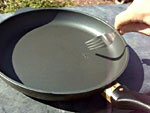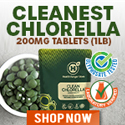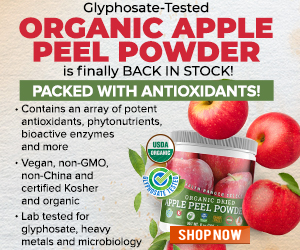
Consumer fraud alert: Swiss Diamond non-stick cookware made with same chemical as Teflon
 Monday, November 13, 2006 Monday, November 13, 2006by Mike Adams, the Health Ranger Editor of NaturalNews.com (See all articles...) Tags: noads, non-stick cookware, Swiss Diamond |
- Hidden poison in your medicine and supplements: How phthalates in capsules are silently attacking your heart, thyroid, and hormones
- X-class solar flare sparks worldwide disruptions, with more storms expected as sunspot turns toward Earth
- Brushing with poison: Study finds toxic heavy metals in 90% of toothpaste brands, including those for children
- The truth about Benzyl Alcohol in beauty products
- DOJ targets controversial “Proximal Origin” study in push for scientific transparency
- HHS launches Generation Gold Standard, ushering in UNIVERSAL FLU VACCINE spearheaded by Bill Gates
- Gaddafi's prophecy unfolds: How NATO's destruction of Libya fueled Europe's migration crisis
- Australia’s vaccine cover-up: 35 died same day as COVID shot, but authorities ignored them
- EU court exposes secret Pfizer deal, orders von der Leyen and Bourla to reveal concealed texts
- OUTRAGE: Georgia shields pesticide giants from cancer lawsuits as corporate lobbying silences victims
- Renegade cardiologist joins MAHA, demands immediate halt to mRNA vaccines and overhaul of US health policies
- Big Pharma's Dirty Secret: How Prescription Drugs Are Starving Your Body of Essential Nutrients
- Breakthrough study links mRNA vaccines to irreversible female fertility loss
- FDA cracks down on unapproved fluoride drugs for kids as science exposes decades of deception
- Canada's COVID cover-up: Health officials swore secrecy to protect Trudeau from vaccine scandal
- Lard: A highly nutritious but misunderstood superfood
- Singapore's draconian vaccine mandate: Citizens face jail time for refusing FORCED medical procedures that do HARM
- When the storm brings spies: How a top weather app became an agent of surveillance
- Singapore's draconian vaccine mandate: Citizens face jail time for refusing FORCED medical procedures that do HARM
- WAR ON COGNITION: The Coordinated Assault on Your Brain and How to Defend Yourself Against Every Attack
- Big Pharma's Dirty Secret: How Prescription Drugs Are Starving Your Body of Essential Nutrients
- JESUS NEVER SPOKE ENGLISH: Historical facts on why the Bible you’re probably reading has been altered, redacted or hidden from much of its original meaning
- Canada's COVID cover-up: Health officials swore secrecy to protect Trudeau from vaccine scandal
- RED ALERT: Nuclear War Between India and Pakistan Could Trigger Global Catastrophe… full RISK ANALYSIS
- Gene-edited pork sneaks onto your plate: FDA quietly approves CRISPR pigs amid health and ethical concerns
- Silent catastrophe: COVID-19 vaccines linked to plummeting fertility rates, Czech data reveals
- Nicole Shanahan exposes RFK Jr.'s 'Broken Promise' - Claims Surgeon General Pick Casey Means is a 'Manchurian Asset' in shocking allegation
- EU embraces censorship over solutions as energy grid crises spark blackout fears
- Why All Government Officials and Big Tech CEOs Who Engage in Systematic Viewpoint Censorship Must Be ARRESTED, Prosecuted, and Sentenced to Life in Prison
- Texas governor threatens San Marcos over pro-ceasefire resolution, igniting free speech debate
- Polar ice rebounds confound alarmist predictions: New studies highlight climate's unpredictable dance
- Survival basics: 5 Dangerous locations to avoid during an EMP attack
- Health Ranger Report: Christopher Bjerknes challenges conventional narratives about world history
- Landmark study of 85 million reveals shocking surge in heart attacks, strokes, and sudden death following the notorious COVID-19 jab
- Spike protein found in stroke victims’ brains up to 17 months after injection, study reveals
- Virologist who endorsed HCQ for COVID-19 appointed to top pandemic post at HHS
- The Miraculous Healing Power of DMSO: Nature's Forgotten Cure for Cancer, Pain, and Regeneration
- Biblical truth: God will carry out a “cosmic reset” of Earth and destroy all human civilization with a series of extinction-level cosmic impacts known as The Seven Trumpets, Seven Bowls and Seven Seals
- URGENT REPORT: The China Import Embargo - What to Stockpile Now Before America Runs Out
- The Ultimate Survival Guide to Baking Soda: A Miraculous, Multi-Purpose Remedy for Health, Home, and Emergency Preparedness
- Widespread social and economic unrest: Steve Quayle issues urgent financial warning of imminent asset collapse in new interview with Mike Adams
- Aerosolized bioweapons? Strange “diploid biomasses” falling out of the sky in Florida captured under the microscope
- A call to preserve America’s future: “Defeating Big Government Socialism” by Newt Gingrich
- Stunning Visualization of the Seven Trumpets in the Book of Revelation
- Big Pharma launches “Vaccine Integrity Project” to combat Secretary Kennedy and keep 94 shots going into kids with mandates and liability protections
- World Economic Forum's current downfall exposes legacy of totalitarianism, financial fraud, and crimes against humanity
- Biden regime deployed over 600 grants to fund disinformation agenda, to silence the truth and stifle debate
- The Miraculous Healing Power of Green Tea: Unlocking the Potent Antioxidants That Big Pharma Doesn't Want You to Know About
- Russia escalates censorship war, targets over 200 VPN apps amid Google resistance
- Kiss Your Genetic Privacy Good-Bye! 23andMe Gets Green Light to Sell Your Intimate Genetic Details to Anyone They Want
- The unspoken truth about chemotherapy: These “treatments” create toxic time bombs in your body called CELL-KILLING PARTICLES
- A win for free speech: State Department SHUTS DOWN controversial disinformation office
- U.S. Government's Bio-War Against America: 15 Historical Medical Horrors Inflicted on the American People by the Government Itself
- U.S. demands U.K. protect FREE SPEECH, repeal hate speech authoritarianism, in latest trade deal negotiations
- Red Cross issues warning to stop blood plasma donations from vaccinated people
- Scientists confirm: GENIUS brain function can be spontaneously unleashed in humans without any apparent cause
- EPA advisor admits the agency is funneling billions to climate groups ahead of Trump’s return to White House
- HYSSOP: What research reveals about the health benefits of this ancient holy herb
- Two containers with completed ballots fall out of truck in Florida
- Newly released JFK files reveal Pentagon's role in creating Lyme disease and covid in the same lab
- Mike Adams releases country western hit single: Goin’ Back in Time is Comin’ Home
- Global leaders unite to clamp down on “misinformation” with UN-backed Cascais Declaration
- BREAKING: 2025 NDAA authorizes mandatory military draft of WOMEN across America… as Pentagon pursues global NUCLEAR war with both Russia and China at the same time
- I Want My Bailout Money – new song released by Mike Adams
- Michael Yon warns of a ZIONIST TAKEOVER in Trump’s second administration
- The Health Ranger releases “Vaccine Zombie” song and music video, using AI-animated zombies for the music video
- Ozempic and Wegovy weight loss drugs are injectable LIZARD VENOM PEPTIDES that may unleash a devastating wave of organ failure… side effects align with symptoms of SNAKE BITES
- BOMBSHELL: DNA testing kits are a SCAM to develop ethnic-specific bioweapons
- These 13 countries just signed an agreement to engineer a global FAMINE by destroying food supply
- Israeli soldiers accused of even more torture and abuse in the West Bank
- RFK Jr. clears key hurdle: Sen. Susan Collins backs controversial HHS nominee, signaling a new era for health policy
- Sermon 30: How Jesus reveals Caesar’s FAKE CURRENCY and FALSE AUTHORITY
This article is about what I discovered with the Swiss Diamond pans. Based on what I have learned and will share with you here through photographs, web page snapshots, videos and microscopic evidence, it is my personal opinion that the Swiss Diamond company is engaged in deceptive marketing based on false and misleading claims about the chemical composition and durability of their non-stick cookware products. I believe that consumers are being fooled into buying Swiss Diamond pans based on the false impression that these pans are Teflon free and that the non-stick surface is made primarily of diamonds. As you will learn here, this is far from the truth.
The promise of safe non-stick cookware
At first, the promotional literature for the Swiss Diamond pans sounds very promising. Websites selling the cookware claim, "The cookware is made with synthetic diamonds! Diamonds will heat up fast and evenly without any hot spots." Or, "This cookware line was awarded the Gold Medallion at the Inventor's Fair in Geneva." (Comments found on various online retailers through a Google search for "Swiss Diamond cookware.")The pans are also characterized as, "One of the most durable cookware lines on the market today. Their superior non-stick coating is able to withstand the abuse of metal utensils and dishwashers."
The NextTen catalog (www.NextTen.com) specifically implies that Swiss Diamons pans contain no Teflon:
"Ordinary non-stick surfaces can't handle those high cooking temperatures. They start to break down and degrade on some stovetops. Even the EPA is studying the potential dangers in the toxic breakdown of the most famous non-stick surface. Instead, Swiss Diamond forms a virtually indestructible surface that will not crack, peel or blister..."
There's a strict avoidance of the word Teflon in all the promotional literature I've seen on Swiss Diamond cookware. Teflon isn't on the product box and, in fact, the SwissDiamond.com website insists the product contains no Teflon whatsoever! From the company's FAQ documents at http://www.swissdiamond.com/faq/faq.html (click thumbnail on the right to view the screen capture yourself):
 Question: Does Swiss Diamond surface contain “TEFLON”?
Question: Does Swiss Diamond surface contain “TEFLON”?
Answer: NO! The Swiss Diamond coating does not contain any Teflon taking into consideration that “Teflon” is a trade mark, made and owned by “DUPONT”.
Both the product box and the website heavily emphasize the benefits of cooking on diamonds with claims like, "Diamonds make the difference!" and "Perfect heat distribution!" The point seems to be distracting consumers from what the pan is really made of and keeping them focused on a minor ingredient: the diamonds.
Nano-composite of what?
So what does the non-stick cooking surface actually contain, then? The box describes it as a "nano-composite," which sounds really high-tech. Plus, "diamonds" are always strongly emphasized. The impression I got when shopping for this product is that I would be cooking on diamonds, and that whatever the nano-composite was made of, it would certainly be safer than Teflon.I wrote the Swiss Diamond company and asked for an explanation of what the nano-composite material was made of. After a week or so, I received a polite reply from Allan Wolk, an employee in the U.S. His email informed me that, "Our patented nonstick surface uses a nano-composite of real diamond crystals and PTFE; it is applied using a computer controlled plasma gun at very high temperatures."
Naturally, my attention was immediately drawn to the PTFE. The acronym sounded familiar. What was PTFE?
A quick search of Wikipedia provided the answer: (http://en.wikipedia.org/wiki/PTFE)
As Wikipedia explains:
Polytetrafluoroethylene (PTFE) is a fluoropolymer discovered by Roy J. Plunkett (1910–1994) of DuPont in 1938. It was introduced as a commercial product in 1946 and is generally known to the public by DuPont's brand name Teflon®.
Huh? Teflon? Wait a minute. Didn't the Swiss Diamond website just claim that the product contained no Teflon?
If you look back at the Swiss Diamond website screen capture, the careful wording of their answer now becomes clear. It states, "The Swiss Diamond coating does not contain any Teflon taking into consideration that “Teflon” is a trade mark, made and owned by DUPONT."
So the pans don't contain Teflon, they just contain the chemical called Teflon. It's like saying a nuclear warhead doesn't contain any plutonium, it only contains nuclear fissionable material.
For the manufacturer to insist the Swiss Diamond pans contain no Teflon whatsoever when it is made primarily from polytetrafluoroethylene, the chemical widely known as Teflon, is extremely deceptive. In fact, the intent of the Swiss Diamond company seems to be to deceive consumers by omission of the facts. The FAQ document on the Swiss Diamond website, for example, does not bother to say something like, "But our pans do contain PTFE, the chemical known as Teflon." It simply insists they contain no Teflon and moves on to the next question.
It seems that Swiss Diamond goes out of its way to give the impression that this product is free of Teflon chemicals and is surfaced primarily with diamonds. That's the impression I got, anyway, and I read the promotional materials several times before purchasing the pan.
Consumers have been hoodwinked
Apparently, I'm not the only one who thought the Swiss Diamond pans offered a replacement for Teflon. A prominent user comment found at the Amazon.com sales page for these pans says:My wife now prefers diamonds in her cookware instead of Teflon. After years of eating out of Teflon cookware and ingesting how many pounds of Teflon over the years, I have finally seen cookware that lives up to the name of nonstick. Instead of using Pam spray or butter on old used Teflon frying pans, I can now cook without butter, (or maybe just a touch of butter, I still love the taste) and get a perfect egg. Throw away all those old wooden utensils. You can now use metal spatula's or that old spoon to stir the pot without getting hollered at for scratching the pans. My wife is happy so I'm happy and cleanup is a snap. - Robert Fry, "Diamonds are forever and cost more than Teflon," posted March 7, 2006
It is clear from this user comment that Robert Fry believes the Swiss Diamond pans contain no Teflon. This false belief is widespread among both consumers and retailers, and it appears to be reinforced by the Swiss Diamond company's marketing materials which specifically attempt to distance the company from Teflon even though its own pans are made with precisely the same chemicals.
The NextTen.com catalog mentioned earlier also seems to have been hoodwinked. Their catalog says, "Even the EPA is studying the potential dangers in the toxic breakdown of the most famous non-stick surface. Instead, Swiss Diamond forms a virtually indestructible surface..." What the NextTen catalog fails to mention, though, is that the "most famous non-stick surface" is made of polytetrafluoroethylene, the exact same chemical used in Swiss Diamond pans!
Yet the deception doesn't end there. The Swiss Diamond company also makes utterly outrageous and false claims concerning the durability of its pans.
Virtually indestructible!
We all know that diamonds are extremely durable, right? The Swiss Diamond company plays on this common knowledge by associating the diamond content of their non-stick cooking surface with the idea that their pans are "indestructible."
 As you can see from the photo of the Swiss Diamond pan box (click the thumbnail), the box proudly proclaims, "Diamonds make the difference!" and that the pan is, "Virtually indestructible." That's quite an impressive claim. It also claims to provide, "Perfect heat distribution" -- a claim that I'm sure NASA's space shuttle engineers would be quite interested in learning about (if it were actually true).
As you can see from the photo of the Swiss Diamond pan box (click the thumbnail), the box proudly proclaims, "Diamonds make the difference!" and that the pan is, "Virtually indestructible." That's quite an impressive claim. It also claims to provide, "Perfect heat distribution" -- a claim that I'm sure NASA's space shuttle engineers would be quite interested in learning about (if it were actually true).
 Adding to the claims, text on the side of the box (click photo thumbnail to see) also claims that, "Diamond crystals form an indestructible non-stick cooking surface that will not crack, blister or peel."
Adding to the claims, text on the side of the box (click photo thumbnail to see) also claims that, "Diamond crystals form an indestructible non-stick cooking surface that will not crack, blister or peel."
"Indestructible" is a big claim. It brings to mind Consumer Reports testing of the pan with rifles, blowtorches and power tools. But I decided to give the pan a much simpler test: the fork test. If the pan's surface is indestructible, it certainly would stand up to simple scratching by a fork, right?
The video evidence: The fork test
 Here's where the video comes in. To avoid any claims that this test was faked or altered in any way, I decided to film the fork test live. Click the thumbnail on the right (QuickTime required), and you'll view a quick video where I easily and quite visibly scratched the surface of the Swiss Diamond pan with a common household fork. (Right click the image and choose Save Target As to download the video to your computer.)
Here's where the video comes in. To avoid any claims that this test was faked or altered in any way, I decided to film the fork test live. Click the thumbnail on the right (QuickTime required), and you'll view a quick video where I easily and quite visibly scratched the surface of the Swiss Diamond pan with a common household fork. (Right click the image and choose Save Target As to download the video to your computer.)
This was done with a regular household fork, right out in broad daylight on my back patio. It didn't take any special effort or power tools.
 Here's a photo showing the results of the fork scratch test (click thumbnail). As you can see from this photograph, the pan was quite easily scratched by my "fork test."
Here's a photo showing the results of the fork scratch test (click thumbnail). As you can see from this photograph, the pan was quite easily scratched by my "fork test."
The non-stick "diamond nano-composite" surface hardly seems indestructible, doesn't it? Indestructible would, I think, include not being harmed by a simple fork scratch. And it makes you wonder: if a fork can scratch the pan so easily, at room temperature, how vulnerable is the pan to scratching by metal utensils at high temperature?
Clearly, the Swiss Diamond cooking surface is quite destructible. If it can be damaged with a fork, it will quite obviously be just as easily damaged by metal cooking utensils.
 In fact, the pan is so easy to scratch that I was able to scratch the word, "FRAUD" into the surface using that same fork. Click the thumbnail to see it yourself.
In fact, the pan is so easy to scratch that I was able to scratch the word, "FRAUD" into the surface using that same fork. Click the thumbnail to see it yourself.
This little test cost me $99, by the way, because I had to toss the pan afterwards. But what else was I supposed to do with the pan? I sure wasn't going to eat off it!
Microscopic evidence
In police crime investigations, forensics experts use microscopes to get a closer look at the evidence. I decided to do the same here. Using a 200x video microscope, I examined the surface of the pan after scratching it with a fork.
 In the first video (click thumbnail to view), you can clearly see the gash cut into the "indestructible" surface by my fork test. This shows, right up close, just how easily the non-stick cooking surface is destroyed by common kitchen utensils.
In the first video (click thumbnail to view), you can clearly see the gash cut into the "indestructible" surface by my fork test. This shows, right up close, just how easily the non-stick cooking surface is destroyed by common kitchen utensils.
At this magnification, it looks like an airliner crashed here. You can clearly see the width and length of one of the fork scratches. It is certainly not anything close to "indestructible," or else there would be no scratch at all.
 In this second video (click thumbnail to view, QuickTime required), you clearly see bits and pieces of the non-stick surface that have been scratched away from the surface by my fork test.
In this second video (click thumbnail to view, QuickTime required), you clearly see bits and pieces of the non-stick surface that have been scratched away from the surface by my fork test.
What's important to note here is that this is what you are eating when you cook food on any Teflon surface that gets scratched. This is how these PTFE chemicals ("Teflon" by the DuPont name) get into your body -- they are scratched off the pan with cooking utensils, then blended into the foods that you later swallow.
Take a close look at these chunks of PTFE. They're jagged, scary-looking chunks of synthetic chemicals that have no place in the human body. Do you really want to eat this? And keep in mind that I easily scraped off these bits with a common fork. Imagine what a metal spatula might do after scrambling eggs, flipping burgers or stir-frying some vegetables.
Consumer fraud? You be the judge...
So here we have a pan marketed as being made with diamonds that render the surface "indestructible." It's hyped up with cool-sounding technology jargon like "nano-composite." The manufacturer blatantly claims the product contains no Teflon whatsoever, and says the pan is safe for your health.But what's the reality here? In reality:
- The nano-composite non-stick cooking surface is made primarily with PTFE, the chemical known as Teflon.
- The pan is marketed as a product that contains NO Teflon and is safe for your health.
- The non-stick surface scratches easily with a common fork.
- Scratching the surface with a household fork causes microscopic bits of the composite material (PTFE and diamonds) to be released into the food being cooked, whereby they are swallowed by consumers.
- The marketing of Swiss Diamond cookware heavily emphasizes "diamonds" while seemingly going out of its way to avoid mentioning Teflon or PTFE chemicals. It appears to give consumers the impression that they are "cooking on diamonds."
- Consumers are being widely misled into believing that this product is an alternative to Teflon when, in reality, it's made of the same thing as Teflon!
- Swiss Diamond pans are being marketed by some of the best-known retailers and catalog companies in the world, including Amazon.com, NextTen catalog and hundreds of others.
To my knowledge, the FTC has taken no action against the Swiss Diamond company. Perhaps after reading this article, they will take a closer look. You can bet that the Swiss Diamond company will scramble to make immediate modifications to its website and product marketing materials, including its box. Once exposed, companies like this try to eliminate the evidence as quickly as possible and act like they were never engaged in any kind of deceptive marketing practices or product claims.
The most likely outcome of all this, of course, is that the Swiss Diamond company will threaten me with legal action for daring to go public with the truth about their products. But that's why I've backed up everything here with undeniable evidence, plus the support of half a million readers who would be quite interested in hearing more stories about a company that tried to attack NewsTarget for reporting the truth.
A blemish on the good Swiss name
The Swiss name that even sounds trustworthy, doesn't it? The Swiss are great people, and I have great respect for their country, culture and history. But allowing a product like this onto the market -- a product that in my opinion blatantly deceives consumers -- tarnishes the good reputation of the Swiss name. The word "Swiss" is usually associated with things you trust, such as Swiss Army knives, or Swiss watches. But as consumers, we must learn to look past any such assumptions of quality or safety related to the word "Swiss" and examine the facts before us. Because in this case, the product claims have more holes than Swiss cheese.My advice? Steer clear of Swiss Diamond pans, unless, of course, you have a great inner desire to pay $99 for a $20 Teflon pan fluffed up with marketing hype and deceptive product claims. And be wary of health claims from any non-stick cookware.
To my knowledge, the only healthy surfaces to cook on are cast iron, stainless steel (like a giant wok), and Pyrex (but Pyrex isn't for stovetop use anyway).
Want to stay informed about more consumer fraud alerts like this one? Subscribe to our free Natural Health Newsletter (see below) and you'll receive free email alerts when we publish similar investigative stories.
Permission granted to quote from this story as long as credit is given to Mike Adams, www.NewsTarget.com
###
Noads at FETCH.news
Get independent news alerts on natural cures, food lab tests, cannabis medicine, science, robotics, drones, privacy and more.
 About the author:Mike Adams (aka the "Health Ranger") is a best selling author (#1 best selling science book on Amazon.com) and a globally recognized scientific researcher in clean foods. He serves as the founding editor of NaturalNews.com and the lab science director of an internationally accredited (ISO 17025) analytical laboratory known as CWC Labs. There, he was awarded a Certificate of Excellence for achieving extremely high accuracy in the analysis of toxic elements in unknown water samples using ICP-MS instrumentation. Adams is also highly proficient in running liquid chromatography, ion chromatography and mass spectrometry time-of-flight analytical instrumentation.
About the author:Mike Adams (aka the "Health Ranger") is a best selling author (#1 best selling science book on Amazon.com) and a globally recognized scientific researcher in clean foods. He serves as the founding editor of NaturalNews.com and the lab science director of an internationally accredited (ISO 17025) analytical laboratory known as CWC Labs. There, he was awarded a Certificate of Excellence for achieving extremely high accuracy in the analysis of toxic elements in unknown water samples using ICP-MS instrumentation. Adams is also highly proficient in running liquid chromatography, ion chromatography and mass spectrometry time-of-flight analytical instrumentation.
Adams is a person of color whose ancestors include Africans and Native American Indians. He's also of Native American heritage, which he credits as inspiring his "Health Ranger" passion for protecting life and nature against the destruction caused by chemicals, heavy metals and other forms of pollution.
Adams is the founder and publisher of the open source science journal Natural Science Journal, the author of numerous peer-reviewed science papers published by the journal, and the author of the world's first book that published ICP-MS heavy metals analysis results for foods, dietary supplements, pet food, spices and fast food. The book is entitled Food Forensics and is published by BenBella Books.
In his laboratory research, Adams has made numerous food safety breakthroughs such as revealing rice protein products imported from Asia to be contaminated with toxic heavy metals like lead, cadmium and tungsten. Adams was the first food science researcher to document high levels of tungsten in superfoods. He also discovered over 11 ppm lead in imported mangosteen powder, and led an industry-wide voluntary agreement to limit heavy metals in rice protein products.
In addition to his lab work, Adams is also the (non-paid) executive director of the non-profit Consumer Wellness Center (CWC), an organization that redirects 100% of its donations receipts to grant programs that teach children and women how to grow their own food or vastly improve their nutrition. Through the non-profit CWC, Adams also launched Nutrition Rescue, a program that donates essential vitamins to people in need. Click here to see some of the CWC success stories.
With a background in science and software technology, Adams is the original founder of the email newsletter technology company known as Arial Software. Using his technical experience combined with his love for natural health, Adams developed and deployed the content management system currently driving NaturalNews.com. He also engineered the high-level statistical algorithms that power SCIENCE.naturalnews.com, a massive research resource featuring over 10 million scientific studies.
Adams is well known for his incredibly popular consumer activism video blowing the lid on fake blueberries used throughout the food supply. He has also exposed "strange fibers" found in Chicken McNuggets, fake academic credentials of so-called health "gurus," dangerous "detox" products imported as battery acid and sold for oral consumption, fake acai berry scams, the California raw milk raids, the vaccine research fraud revealed by industry whistleblowers and many other topics.
Adams has also helped defend the rights of home gardeners and protect the medical freedom rights of parents. Adams is widely recognized to have made a remarkable global impact on issues like GMOs, vaccines, nutrition therapies, human consciousness.
In addition to his activism, Adams is an accomplished musician who has released over a dozen popular songs covering a variety of activism topics.
Click here to read a more detailed bio on Mike Adams, the Health Ranger, at HealthRanger.com.
Take Action: Support Natural News by linking to this article from your website
Permalink to this article:
Embed article link: (copy HTML code below):
Reprinting this article:
Non-commercial use OK, cite NaturalNews.com with clickable link.
Follow Natural News on Facebook, Twitter, Google Plus, and Pinterest
Science News & Studies
Medicine News and Information
Food News & Studies
Health News & Studies
Herbs News & Information
Pollution News & Studies
Cancer News & Studies
Climate News & Studies
Survival News & Information
Gear News & Information
News covering technology, stocks, hackers, and more



"Big Tech and mainstream media are constantly trying to silence the independent voices that dare to bring you the truth about toxic food ingredients, dangerous medications and the failed, fraudulent science of the profit-driven medical establishment.
Email is one of the best ways to make sure you stay informed, without the censorship of the tech giants (Google, Apple, Facebook, Twitter, YouTube, etc.). Stay informed and you'll even likely learn information that may help save your own life."
–The Health Ranger, Mike Adams












































